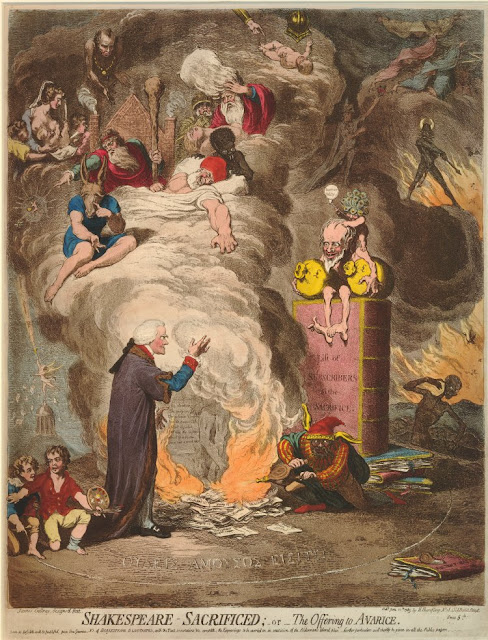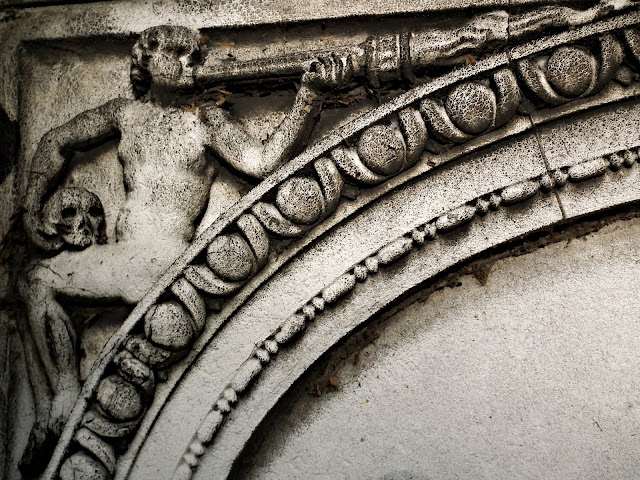The
tightly packed and heavily populated warrens of the medieval City of London
were full of religious buildings; there was a monastery, priory, nunnery, chapel,
church or cathedral on virtually every street.
In the aftermath of the Great Fire of London the population thinned out as the new streets were widened and regulation was finally imposed on the previously chaotic building practices of the
city. The number of parishes was culled as a result of the falling population. Continuing development
of the city as a commercial and financial rather than residential centre in the
19th century drastically reduced the population of the remaining city parishes
even further, to the point that by the 1850’s there were sometimes more officiating clergy
than worshippers at religious services. The 1860 Union of Benefices Act allowed the Church
of England to rationalise the number of parishes and to dispose of unwanted
buildings and land, including burial grounds and churchyards. By the 1880’s the population of the seven pre 1666 city parishes of St
Olave Jewry, St Martin Pomeroy, St Mildred Poultry, St Mary Colechurch, St Christopher le-Stocks,
St Bartholomew-by-the- Exchange and St Margaret Lothbury had fallen to just
601. All seven parish churches were destroyed by the great fire but only five
of them were rebuilt, all to designs by Sir Christopher Wren; St Martin’s was
joined to St Olaves and St Mary’s to St Mildreds. Only St Margaret Lothbury
still stands, the rest have all been demolished.
 |
| St Olave Old Jewry, depicted in the early nineteenth century |
St
Christopher le-Stocks on Threadneedle Street was the first to go, knocked down in
1781 to make way for Sir John Soane’s extension to the Bank of England. St
Bartholomew’s proximity to the Royal Exchange turned into a liability when it
was demolished 1840 in order to improve access to the new exchange building. St
Mildred’s was demolished in 1871 and in 1884 the Ecclesiastical Commissioners
turned their attention to St Olave Old Jewry. The Graphic was appalled; it called St Olave’s “a beautiful
specimen of Wren's architecture,” and appealed “on behalf of the City Church
and Churchyard Protection Society for contributions to its nearly exhausted
funds with which it may oppose these and similar acts of destruction and
desecration.” It did no good; the church was closed in 1887. The St James Gazette was less sentimental
than the Graphic, as St Olave’s “had
no architectural merits, it is impossible to lament over its destruction,” it
said, adding that “doubtless the site, when sold for the erection of one more
block of offices, will bring in money enough to build and endow several
churches in some poor district.” If the Gazette’s feature writer had any
regrets about the demolition of City churches it was “the disappearance of
their picturesque names. It is pleasant, in the wildernesses of industrial and
mercantile London to come across a St. Antholin’s, or St. Olave’s, or St.
Mildred’s, whose titles ‘fall upon the ear like the echo of vanished world.’” Apart
from the tower the church was demolished in 1888. On 18 July 1891 The Star reported that a “placard on
the doors of the church of St. Olave, Old Jewry, gives notice that the fabric
and site of that building will be put up to auction at the Mart.” Two weeks
later the freehold site of the church was offered for sale at the Auction Mart
in Tokenhouse Yard, by Messrs. Edwin Fox and Bousfield and was knocked down for
£22,400. Wren’s tower was retained by the new owners and incorporated into the
new office building they put up on the site of the old churchyard. It still
stands today as the entrance to a much newer office block.
Burials
at St Olave’s continued right up until the 1852 Metropolitan Burial Act
prohibited them, though the number of interments had obviously declined with
the reduction in the living population. Although St Martin Pomeroy, which stood
so close to St Olave’s as to be almost adjacent, had been destroyed in 1666 the
parish burial register continued to be kept separately to St Olave’s until the
early 19th century. The fees for both
parishes were identical; in 1820 £11 for the chancel, vestry and parish vaults and
£1 3s 6d for either churchyard. Prior to the demolition of the church it was
decided to remove all coffins and human remains from the site and rebury them
at the new City of London Cemetery in Ilford. The churchwardens gave notice to
the known relatives of anyone buried within the church or in the churchyard that
they had 3 months to remove their remains. The Ecclesiastical Commissioners had
set up a special fund with which to reimburse the costs of reburial elsewhere,
up to a limit of £10. If no application was received to remove a body by the 1st
December 1887 it would be removed by the Commission for Sewers and reburied in
Ilford. The commission’s workmen dug up the churchyard and broke open the
vaults, removing 216 coffins and 279 cases of bones. The job of taking these to
Ilford was subcontracted to John Shepherd, undertaker of 55 Bishopsgate Street.
At the cemetery the remains were reinterred in a brick lined vault and a new
memorial was erected sacred to all of those formerly buried in the two parishes
but specifically commemorating, in two long lists on either side of the
monument, some of the more worthy deceased. The Frederick
family vault for example contained 27 coffins dating from between 1610 and 1799. Most of them are listed individually
on the memorial including a couple of Frederick baronets, an admiral, a judge,
and Sir Humphrey Weld, Lord Mayor of London in 1608. 61 coffins were
removed from the chancel vault including the Revd Dr Samuel Shepherd.
The
only name I recognised on the memorial was John Boydell the printmaker and
publisher. His wife Elizabeth, who had been his childhood sweetheart and who he
married in 1848, is also listed. According to the St Martin Pomeroy parish
register he was buried on December 19th 1804 in the Doctor’s vault inside the
church. According to Walter Thornbury’s “Old and New London” (1878) the 84 year
old died on the 11th December, his death, “occasioned by a cold, caught at the
Old Bailey Sessions.” He goes on to say
that “it was the regular custom of Mr. Alderman Boydell…, who was a very early
riser, to repair at five o'clock immediately to the pump in Ironmonger Lane.
There, after placing his wig upon the ball at the top, he used to sluice his
head with its water. This well known and highly respected character was one of
the last men who wore a three-cornered hat, commonly called the ‘Egham, Staines,
and Windsor.’” That these crack of dawn, midwinter, open air dousings under the
parish pump didn’t kill him off until he was in his eighties stands testament
to his robust constitution.
Boydell
was born in Shropshire in 1720, the son of a land surveyor. He came to London
in 1740 as an apprentice, to learn the art of engraving. He opened his first
business in 1746 making and selling his own prints. Thornbury’s principal
source for his account of Boydell’s career, ‘Rainy Day’ Smith told him that when
Boydell started publishing “he etched small plates of landscapes, which he
produced in plates of six, and sold for sixpence; and that as there were very
few print-shops at that time in London, he prevailed upon the sellers of
children's toys to allow his little books to be put in their windows. These
shops he regularly visited every Saturday, to see if any had been sold, and to
leave more. His most successful shop was the sign of the 'Cricket Bat,' in
Duke's Court, St. Martin's Lane, where he found he had sold as many as came to
five shillings and sixpence. With this success he was so pleased, that, wishing
to invite the shopkeeper to continue in his interest, he laid out the money in
a silver pencil-case; which article, after he had related the above anecdote,
he took out of his pocket and assured me he never would part with.” He
gradually gave up engraving in favour of making prints of other peoples
designs. He became enormously successful , transforming what had hitherto been
a niche market for imported French prints, into a thriving domestic and export
market in British produced prints.
In
1789 Boydell opened his Shakespeare Gallery on Pall Mall. He commissioned
paintings based on Shakespeare’s works from Britain’s best known artists which
the public paid one shilling to see. The entrance fee was a bargain – the Royal
Academy charged considerably more ‘to prevent the Rooms being filled by
improper Persons’. The real money spinners were the prints of the paintings
produced by a team of 46 printmakers which were available to purchase singly,
as a portfolio or as bound illustrations in a specially commissioned edition of
Shakespeare’s plays. Boydell’s impressive profits enabled him to pay hefty fees
to the artists who produced the paintings. Even Sir Joshua Reynolds, who as
President of the Royal Academy strongly disapproved of Boydell’s gallery and
who thought that prints based on paintings were vulgar, put aside his
objections to the scheme when he was offered 1000 guineas for a single painting
of the three witches from Macbeth.
According to Thornbury George Stevens, the editor of the special edition of
Shakespeare, took it upon himself to persuade Sir Joshua to accept the
commission; “taking a bank-bill of five hundred pounds in his hand, he had an
interview with Sir Joshua, when, using all his eloquence in argument, he, in
the meantime, slipped the bank-bill into his hand; he then soon found that his
mode of reasoning was not to be resisted, and a picture was promised.” The
painter’s scruples completely collapsed in fact and he soon produced 3
paintings for Boydell’s gallery. The most famous of these was a Puck or Robin
Goodfellow painted in 1789. Walpole described it as depicting 'an ugly little
imp (but with some character) sitting on a mushroom half as big as a
mile-stone.' Thornbury, again, describes
the birth of this picture “Mr. Nicholls, of the British Institution, related to
Mr. Cotton that the alderman and his grandfather were with Sir Joshua when
painting the death of Cardinal Beaufort. Boydell was much taken with the
portrait of a naked child, and wished it could be brought into the Shakespeare.
Sir Joshua said it was painted from a little child he found sitting on his
steps in Leicester Square. Nicholls' grandfather then said, 'Well, Mr.
Alderman, it can very easily come into the Shakespeare if Sir Joshua will
kindly place him upon a mushroom, give him fawn's ears, and make a Puck of
him.' Sir Joshua liked the notion, and painted the picture accordingly…. The
merry boy, whom Sir Joshua found upon his door-step, subsequently became a
porter at Elliot's brewery, in Pimlico.” Gillray satirised Boydell and the
Shakespeare Gallery ironically using the very medium Boydell had done so much
to popularise, print making. In ‘Shakespeare sacrificed or the offering to
avarice’ Boydell is shown in his alderman’s robes burning the bard’s works,
producing thick clouds of smoke which support travestied figures from the
paintings commissioned for the gallery, watched by a ancient goblin like figure
clutching two large money bags.











